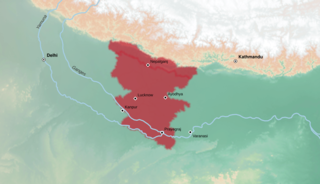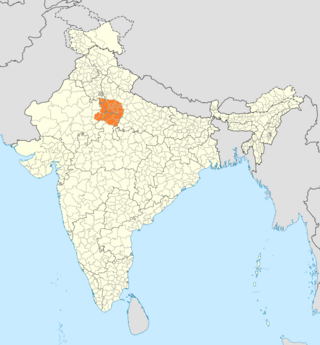Bibliography
- Masica, Colin P. (1991). The Indo-Aryan languages. Cambridge language surveys. Cambridge University Press. pp. 421–2. ISBN 978-0-521-23420-7.
Ahiri may refer to either of the following Indo-Aryan language varieties of India:

The Indo-Aryan languages are a branch of the Indo-Iranian languages in the Indo-European language family. As of the early 21st century, they have more than 800 million speakers, primarily concentrated in Bangladesh, India, Pakistan, Sri Lanka, Maldives and Nepal. Moreover, apart from the Indian subcontinent, large immigrant and expatriate Indo-Aryan–speaking communities live in Northwestern Europe, Western Asia, North America, the Caribbean, Southeast Africa, Polynesia and Australia, along with several million speakers of Romani languages primarily concentrated in Southeastern Europe. There are over 200 known Indo-Aryan languages.

Bundeli or Bundelkhandi is an Indo-Aryan language spoken in the Bundelkhand region of central India. It belongs to the Central Indo-Aryan languages and is part of the Western Hindi subgroup.

The Northern Indo-Aryan languages, also known as Pahāṛi languages, are a proposed group of Indo-Aryan languages spoken in the lower ranges of the Himalayas, from Nepal in the east, through the Indian states of Jammu and Kashmir, Uttarakhand, Himachal Pradesh and Punjab was coined by G. A. Grierson.

Saurashtra is an Indo-Aryan language spoken primarily by the Saurashtrians of Southern India who migrated from the Lata region of present-day Gujarat to south of Vindhyas in the Middle Ages.

Awadhi, also known as Audhi, is an Indo-Aryan language spoken in the Awadh region of Uttar Pradesh in northern India and in Terai region of western Nepal. The name Awadh is connected to Ayodhya, the ancient city, which is regarded as the homeland of the Hindu god Rama. It was, along with Braj, used widely as a literary vehicle before being displaced by Hindi in the 19th century.

The Hindi Belt, also known as the Hindi Heartland, is a linguistic region encompassing parts of northern, central, eastern, and western India where various Northern, Central, Eastern and Western Indo-Aryan languages are spoken, which in a broader sense is termed as Hindi languages, with Standard Hindi serving as the lingua franca of the region.
The Western Pahari is a group of Northern Indo-Aryan languages or a dialect continuum spoken in northwestern India, primarily in the state of Himachal Pradesh and Jammu.
Dramatic Prakrits were those standard forms of Prakrit dialects that were used in dramas and other literature in medieval India. They may have once been spoken languages or were based on spoken languages, but continued to be used as literary languages long after they ceased to be spoken. Dramatic Prakrits are important for the study of the development of Indo-Aryan languages, because their usage in plays and literature is always accompanied by a translation in Sanskrit.

Braj is a language within the Indo-Aryan language family spoken in the Braj region centered on Mathura. Along with Awadhi, it was one of the two predominant literary languages of North-Central India before being replaced by Hindi in the 19th century.

Chittagonian or Chittagonian Bengali is an Indo-Aryan language spoken in parts of the Chittagong Division in Bangladesh. Its speakers identify with Bengali culture and the Bengali language. Chittagonian and Standard Bengali are not inherently mutually intelligible, although it is considered as a nonstandard Bengali dialect. Chittagonian is considered to be a separate language by some linguists. It is mutually intelligible with Rohingya and to a lesser extent with Noakhailla. It is estimated (2006) that Chittagonian has 13 million speakers, principally in Bangladesh.
Magadhi Prakrit (Māgadhī) is of one of the three Dramatic Prakrits, the written languages of Ancient India following the decline of Pali and Sanskrit. It was a vernacular Middle Indo-Aryan language, replacing earlier Vedic Sanskrit.
Baltic Romani is group of dialects of the Romani language spoken in the Baltic states and adjoining regions of Poland and Russia. Half of the speakers live in Poland. It also called Balt Romani, Balt Slavic Romani, Baltic Slavic Romani, and Roma. Romani began as an Indo-European language, which morphed into an Indo-Iranian language, and then into an Indo-Aryan language. After that the Romani language broke down into Balkan Romani and Central Romani. Baltic Romani came from the Central Romani dialect which branches off into other dialects. There are a total of around 31,500 users in all countries.

The Tharu or Tharuhat languages are any of the Indo-Aryan languages spoken by the Tharu people of the Terai region in Nepal, and neighboring regions of Uttarakhand, Uttar Pradesh and Bihar in India.
Pahari, or Pahadi is an ambiguous term that has been used for a variety of languages, dialects and language groups, most of which are found in the lower Himalayas.

The Punjabi dialects and languages or Greater Panjabic are a series of dialects and languages spoken around the Punjab region of Pakistan and India with varying degrees of official recognition. They have sometimes been referred to as the Greater Punjabi macrolanguage. Punjabi may also be considered as a pluricentric language with more than one standard variety.

Bilaspuri, or Kahluri (Takri:𑚊𑚩𑚥𑚱𑚤𑚯) is a language spoken in northern India, predominantly in the Bilaspur district of Himachal Pradesh. It is associated with the people of the former princely state of Bilaspur in the Panjab Hills.
Powari is an Indo-Aryan language spoken primarily in Madhya Pradesh and Eastern Maharashtra.
Rangri may refer to the following Indo-Aryan dialects:

Gaddi is an Indo-Aryan language of India. It is spoken by the Gaddi people primarily residing in Bharmour region of Chamba district and upper reaches of Kangra district in Himachal Pradesh. It is also spoken in neighbouring parts of Jammu, with Gaddi villages found in Udhampur, Kathua and Doda districts.
Desia, also Desiya or Desia Odia or Koraputi Odia or Southwestern Odia, is an Indo-Aryan language variety spoken in Koraput, Nabarangpur, Rayagada, Malkangiri districts Odisha and in the hilly regions of Vishakhapatnam and Vizianagaram districts of Andhra Pradesh. The variant spoken in Koraput is called Koraputia.